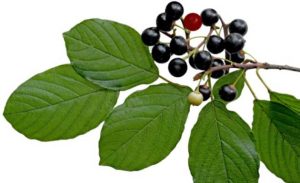
Family:: Rhamnaceae
Other names: Cascara Sagrada, Rhamni Purshianae Cortex, Rhamnus, Chittem bark, Sacred bark, Bearberry, Bear-wood
Habitat: The plant is indigenous to the western part of North America and is cultivated on the Pacific coast of the U.S., Canada and in eastern Africa.
Constituents
Anthracene glycosides, linoleic acid, myristic acid, syringic acid, lipids, resin and tannin.
Action
Purgative, long-term treatment of constipation, chronic indigestion, cirrhosis and jaundice, haemorrhoids, gastric headache, broad/flabby tongue, foul breath
Use
It is a non-habit forming stimulant laxative, pancreatic stimulant, bitter tonic and mild purgative. Used for habitual constipation, torpor of low bowel, congestion of liver and gall duct, to assist liver function in cirrhosis and foul or bad breath.
The German Commission E approved use for treatment of constipation.
‘Cascara is a bitter tonic of specific value in its direct influence upon the function of the stomach and intestinal canal. It acts upon the vasomotor system, stimulating the glandular apparatus of the intestinal tract to more perfect secretion, and increasing peristaltic action. It is especially indicated in torpidity or atonicity, quickly restoring functional activity.’ (Ellingswood p.370)
Note: Cascara bark increases in virtue the longer it is kept by a slow process of oxidation.
Food Use: Cascara is listed by the Council of Europe as a natural source of food flavouring (category N4). Previously, in the USA, cascara has been approved for food use.
Medicinal Parts
Dried Bark
Not to be Confused With: The bark of other Rhamnus species.
Clinical studies
Studies involving elderly patients suggest that cascara treatment, compared with placebo, leads to relief of constipation and increased bowel movements.
Dosage
Dosages for oral administration (adults) for traditional uses recommended in older and contemporary standard herbal reference texts are given below:
Dried bark: 0.3–1 g as a single daily dose.
Infusion: 1.5–2 g of dried bark in 150 mL hot water.
Tablets: 150mg. 1-2 when necessary.
Liquid Extract: 1/2 to 1 teaspoon in water, at bedtime.
Powdered bark: 1 to 2 1/2gm.
It is best to give it in small doses first and gradually increase; then when stool becomes normal continue the last dose for a week or so and then gradually decrease dose and give at longer intervals. Given in this way it has proved to be a valuable remedy in chronic constipation, chronic indigestion, gastric or intestinal catarrh. (Peterson p.59)
Carscara is sometimes combined with Cardamom, Coriander or Cumin as a precaution against griping. It is also used as a common ingredient with Figwort, Witch Hazel or Stone root for piles.
Caution
It should not be given in so large doses as to produce pain or griping. Excessive dosage may result in dehydration with low potassium levels.
Cascara is not recommended for use in children under 10 years of age.
Side-effects/Toxicity
The side-effects and toxicity documented for anthraquinone glycosides are applicable. Cascara is contra-indicated for patients with intestinal obstruction and stenosis, atony, inflammatory diseases of the colon (e.g. Crohn’s disease, colitis), appendicitis, abdominal pain of unknown origin, severe dehydration states with water and electrolyte depletion. Cascara should not be used over an extended period of time – use for more than two weeks requires medical supervision.
Cascara is not recommended be used during pregnancy.
Source:
Herbal Medicines Third edition pub. 2007 by Joanne Barnes, Linda A Anderson, J David Phillipson
PDR for Herbal Medicine pub. 2000 by Joerg Gruenwald, PhD etal
Dr Shook’s Advance Course in Herbology
William Boericke – Pocket Manual Materia Medica
Ellingwood’s American Materia Medica, Therapeutics and Pharmacognosy
Petersen’s Materia Medica
The information provided here are for educational purposes only, and is meant to help users better understand health concerns. This information should not be interpreted as specific medical advice. Users should consult with a qualified healthcare provider for specific questions regarding therapies, diagnosis and/or health conditions, prior to making therapeutic decisions.
DISCLAIMER: THIS WEBSITE DOES NOT PROVIDE MEDICAL ADVICE
The information, including but not limited to, text, graphics, images and other material contained on this website are for informational purposes only. The purpose of this website is to promote broad consumer understanding and knowledge of various health topics. It is not intended to be a substitute for professional medical advice, diagnosis or treatment. Always seek the advice of your physician or other qualified health care provider with any questions you may have regarding a medical condition or treatment and before undertaking a new health care regimen, and never disregard professional medical advice or delay in seeking it because of something you have read on this website.